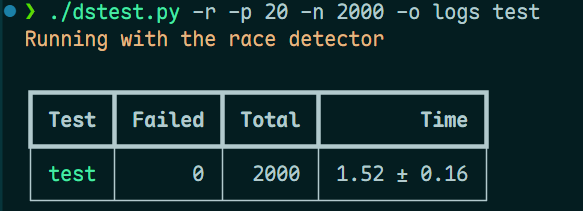MIT 6.5840 (Spring, 2024) 通关指南——Lab 2: Key/Value Server
MIT 6.5840 (Spring, 2024) – Lab 2: Key/Value Server
👨💻 Charles
🔗 实验手册:6.5840 Lab 2: Key/Value Server
✍️ 本系列前文
- MIT 6.5840 (Spring, 2024) 通关指南——入门篇
- MIT 6.5840 (Spring, 2024) 通关指南——Lab 1: MapReduce
文章目录
- MIT 6.5840 (Spring, 2024) -- Lab 2: Key/Value Server
- common.go
- server.go
- client.go
- 实验结果
该 lab 需要实现一个简单的 K/V 存储系统,由于还没涉及分布式,且底层存储可以直接用 map ,写起来难度不大。貌似也是 6.5840 中唯一一个难度标注为 easy 的 lab 了,直接上代码吧。
完整代码见 github
common.go
// Put or Append
type PutAppendArgs struct {Key stringValue string// You'll have to add definitions here.// Field names must start with capital letters,// otherwise RPC will break.ClerkID int64RequestID int64
}type PutAppendReply struct {Value string
}type GetArgs struct {Key string// You'll have to add definitions here.
}type GetReply struct {Value string
}
非常简单,唯一要注意的就是为了“客户端请求去重”, PutAppendArgs 需要携带一下客户端 ID 和这次请求的 ID(唯一):
在不可靠网络中,客户端可能会多次重发相同的 RPC 请求。如果服务器简单处理,多次处理同一个请求会导致重复操作 —— 例如一个写操作被执行多次,导致数据不一致或者越界。为了避免这些问题,服务器需做请求去重并返回幂等的结果。因此这里采用一种常见策略:
- 客户端维护一个单调递增的请求 ID(
RequestID),在每次请求 RPC 中带上。 - 服务器保存每个客户端最近处理过的
lastRequestID和对应的lastReply。 - 当它收到一个请求时,如果发现
RequestID=lastRequestID(即重复请求),它就直接返回已保存的lastReply,而不重复执行。
由于
RequestID是单调递增,且只有客户端确认收到该请求的回复后,才会让RequestID加一,所以不会出现client's RequestID < server's lastReuqestID[client]的情况。
详细实现见下面的 server.go 。
server.go
type KVServer struct {mu sync.Mutex// Your definitions here.db map[string]stringlastRequest map[int64]int64 // clerkID -> its last requestIDlastReply map[int64]string // clerkID -> its last reply value
}func (kv *KVServer) Get(args *GetArgs, reply *GetReply) {// Your code here.kv.mu.Lock()defer kv.mu.Unlock()reply.Value = kv.db[args.Key]
}func (kv *KVServer) Put(args *PutAppendArgs, reply *PutAppendReply) {// Your code here.kv.mu.Lock()defer kv.mu.Unlock()if kv.lastRequest[args.ClerkID] == args.RequestID {return}kv.db[args.Key] = args.Valuereply.Value = args.Value
}func (kv *KVServer) Append(args *PutAppendArgs, reply *PutAppendReply) {// Your code here.kv.mu.Lock()defer kv.mu.Unlock()if kv.lastRequest[args.ClerkID] == args.RequestID {reply.Value = kv.lastReply[args.ClerkID]return}oldValue := kv.db[args.Key]kv.db[args.Key] = oldValue + args.Valuereply.Value = oldValuekv.lastRequest[args.ClerkID] = args.RequestIDkv.lastReply[args.ClerkID] = oldValue
}func StartKVServer() *KVServer {kv := new(KVServer)// You may need initialization code here.kv.db = make(map[string]string)kv.lastRequest = make(map[int64]int64)kv.lastReply = make(map[int64]string)return kv
}
client.go
type Clerk struct {server *labrpc.ClientEnd// You will have to modify this struct.id int64requestID int64
}func nrand() int64 {max := big.NewInt(int64(1) << 62)bigx, _ := rand.Int(rand.Reader, max)x := bigx.Int64()return x
}func MakeClerk(server *labrpc.ClientEnd) *Clerk {ck := new(Clerk)ck.server = server// You'll have to add code here.ck.id = nrand()return ck
}func (ck *Clerk) Get(key string) string {// You will have to modify this function.args := GetArgs{Key: key}reply := GetReply{}try := 0success := falsefor !success {try++success = ck.server.Call("KVServer.Get", &args, &reply)DPrintf("CK[%d] Get[%s], %v; try time: %d", ck.id, key, success, try)}DPrintf("CK[%d] Get[%s] = '%s'", ck.id, key, reply.Value)return reply.Value
}func (ck *Clerk) PutAppend(key string, value string, op string) string {// You will have to modify this function.args := PutAppendArgs{Key: key,Value: value,ClerkID: ck.id,RequestID: atomic.AddInt64(&ck.requestID, 1),}reply := PutAppendReply{}success := falsetry := 0for !success {try++success = ck.server.Call("KVServer."+op, &args, &reply)DPrintf("CK[%d] %s[%s]='%s', %v\ntry time: %d\nrequestID: %d",ck.id, op, key, value, success, try, args.RequestID)}return reply.Value
}func (ck *Clerk) Put(key string, value string) {ck.PutAppend(key, value, "Put")
}// Append value to key's value and return that value
func (ck *Clerk) Append(key string, value string) string {return ck.PutAppend(key, value, "Append")
}
实验结果
用测试脚本跑 2000 轮(打开数据竞态检测),全部通过:

测试脚本配置方法见 MIT 6.5840 (Spring, 2024) 通关指南——入门篇-CSDN博客
